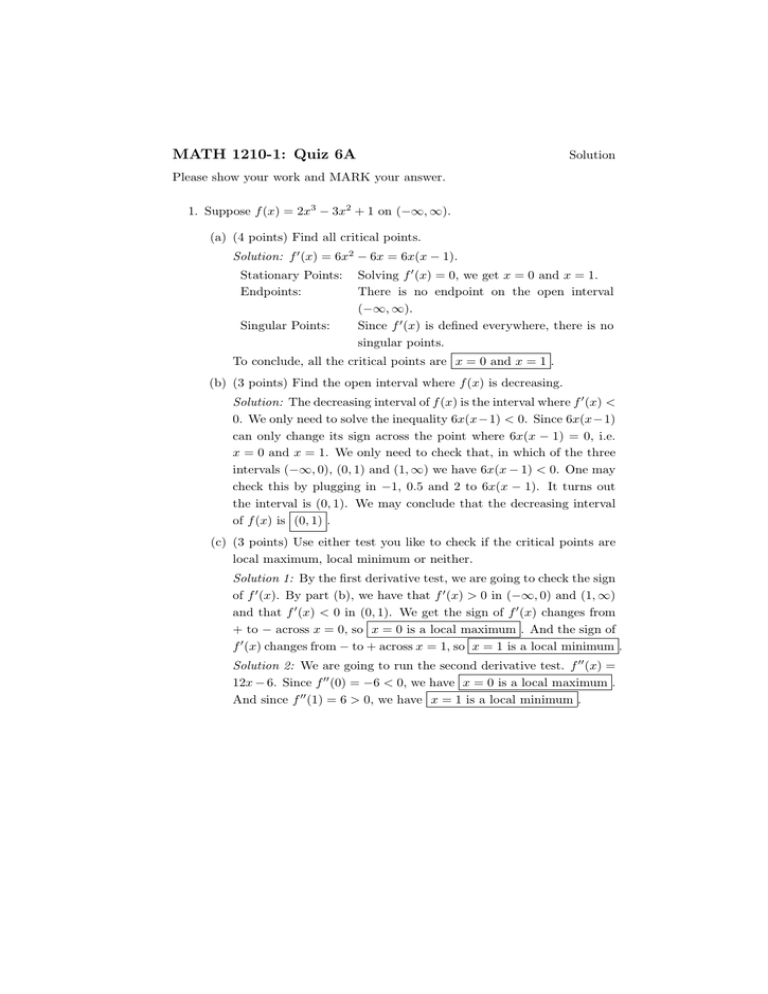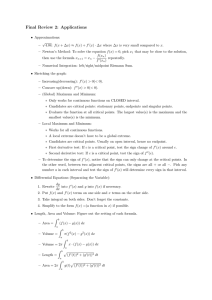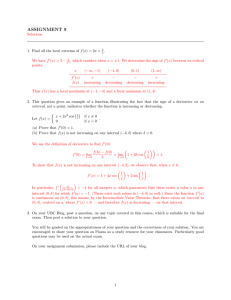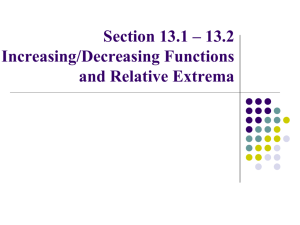MATH 1210-1: Quiz 6A
advertisement

MATH 1210-1: Quiz 6A Solution Please show your work and MARK your answer. 1. Suppose f (x) = 2x3 − 3x2 + 1 on (−∞, ∞). (a) (4 points) Find all critical points. Solution: f 0 (x) = 6x2 − 6x = 6x(x − 1). Stationary Points: Endpoints: Singular Points: Solving f 0 (x) = 0, we get x = 0 and x = 1. There is no endpoint on the open interval (−∞, ∞). Since f 0 (x) is defined everywhere, there is no singular points. To conclude, all the critical points are x = 0 and x = 1 . (b) (3 points) Find the open interval where f (x) is decreasing. Solution: The decreasing interval of f (x) is the interval where f 0 (x) < 0. We only need to solve the inequality 6x(x−1) < 0. Since 6x(x−1) can only change its sign across the point where 6x(x − 1) = 0, i.e. x = 0 and x = 1. We only need to check that, in which of the three intervals (−∞, 0), (0, 1) and (1, ∞) we have 6x(x − 1) < 0. One may check this by plugging in −1, 0.5 and 2 to 6x(x − 1). It turns out the interval is (0, 1). We may conclude that the decreasing interval of f (x) is (0, 1) . (c) (3 points) Use either test you like to check if the critical points are local maximum, local minimum or neither. Solution 1: By the first derivative test, we are going to check the sign of f 0 (x). By part (b), we have that f 0 (x) > 0 in (−∞, 0) and (1, ∞) and that f 0 (x) < 0 in (0, 1). We get the sign of f 0 (x) changes from + to − across x = 0, so x = 0 is a local maximum . And the sign of f 0 (x) changes from − to + across x = 1, so x = 1 is a local minimum . Solution 2: We are going to run the second derivative test. f 00 (x) = 12x − 6. Since f 00 (0) = −6 < 0, we have x = 0 is a local maximum . And since f 00 (1) = 6 > 0, we have x = 1 is a local minimum . MATH 1210-1: Quiz 6B Solution Please show your work and MARK your answer. 1. Suppose f (x) = 2x3 + 3x2 − 1 on (−∞, ∞). (a) (4 points) Find all critical points. Solution: f 0 (x) = 6x2 + 6x = 6x(x + 1). Stationary Points: Endpoints: Singular Points: Solving f 0 (x) = 0, we get x = −1 and x = 0. There is no endpoint on the open interval (−∞, ∞). Since f 0 (x) is defined everywhere, there is no singular points. To conclude, all the critical points are x = −1 and x = 0 . (b) (3 points) Find the open interval where f (x) is decreasing. Solution: The decreasing interval of f (x) is the interval where f 0 (x) < 0. We only need to solve the inequality 6x(x+1) < 0. Since 6x(x+1) can only change its sign across the point where 6x(x + 1) = 0, i.e. x = −1 and x = 0. We only need to check that, in which of the three intervals (−∞, −1), (−1, 0) and (0, ∞) we have 6x(x + 1) < 0. One may check this by plugging in −2, −0.5 and 1 to 6x(x + 1). It turns out the interval is (−1, 0). We may conclude that the decreasing interval of f (x) is (−1, 0) . (c) (3 points) Use either test you like to check if the critical points are local maximum, local minimum or neither. Solution 1: By the first derivative test, we are going to check the sign of f 0 (x). By part (b), we have that f 0 (x) > 0 in (−∞, −1) and (0, ∞) and that f 0 (x) < 0 in (−1, 0). We get the sign of f 0 (x) changes from + to − across x = −1, so x = −1 is a local maximum . And the sign of f 0 (x) changes from − to + across x = 0, so x = 0 is a local minimum . Solution 2: We are going to run the second derivative test. f 00 (x) = 12x+6. Since f 00 (−1) = −6 < 0, we have x = −1 is a local maximum . And since f 00 (0) = 6 > 0, we have x = 0 is a local minimum .

![∈ [ ( ) = ]](http://s2.studylib.net/store/data/010601535_1-6f70cc477c07d559090667d6567ce3dc-300x300.png)




